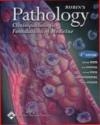Rubin's Pathology with CD
David S. Strayer, Fred Gorstein, Roland Schwarting
Rubin's Pathology with CD
David S. Strayer, Fred Gorstein, Roland Schwarting
- Producent: Lippincott Williams & Wilkins
- Rok produkcji: 2004
- ISBN: 9780781747332
- Ilość stron: 1608
- Oprawa: Twarda
Niedostępna
Opis: Rubin's Pathology with CD - David S. Strayer, Fred Gorstein, Roland Schwarting
Substantially revised with hundreds of new schematic drawings, photographs, and micrographs, the Fourth Edition of "Rubin's Pathology" maintains the clinical approach that is ideal for medical students. This edition is packaged with a brand-new electronic supplement - the Virtual Pathology Slide Set. Students can view digital slides of microscopic specimens with "virtual microscope" viewer software that enables panning, zooming, and magnification. Every copy of the textbook comes with a CD-ROM containing 5 specimens. Faculty and schools wishing to license a more complete set of 100 virtual slides on DVDs can license the Virtual Pathology Slide Set. Doody's Book Review Service, Leonor David, MD, PhD -- "This is the fourth edition of a book that presents a comprehensive clinicopathologic overview of human disease. The book has an excellent balance of medical nomenclature, molecular basis of disease, clinical features, epidemiology, pathogenesis, and pathology... "The purpose is to give students in medical sciences the basic knowledge about pathology needed to understand and handle human diseases. The purpose is fully met through the book's careful and systematic approach that relates pathologic changes to clinical manifestations of disease... "The book covers general mechanisms involved in the pathogenesis of human diseases, using well selected models of cell/molecular biology based information...It includes the classic organ approach and innovative chapters on diseases like diabetes and amyloidosis, that serve as examples to give readers more in-depth information about relevant diseases with a lot of new information from recent years. Drawings, diagrams, and images are of excellent quality. "This is an excellent book where students, researchers, and professionals in medical sciences will find 'pathology literacy,' as the editor puts it in the preface. The clinicopathologic approach used throughout and the excellent quality of figures and illustrations are major advantages of this book compared to others in the field."-Four-Star Review from Doody's Book Review Service (Weighted Numerical Score: 95) Journal of the American Medical Association (JAMA), 15-SEP-04, Volume 292, Issue 11, Syed A. Hoda, MD and Rana S. Hoda, MD -- "The three main challenges in writing a textbook about introductory general and systemic pathology are to inspire the physicians of the future, demonstrate relevance to modern medicine, and keep the covers of the book not too distant. The latest incarnation of Pathology, rechristened Rubin's Pathology: Clinicopathologic Foundations of Medicine, seems to have met each of these challenges with substantial success... "True to its subtitle, the book does not lose sight of the clinical context...The text is terse, illustrations are illuminating, diagrams are discriminating, and tables are tidy. Together these resources provide the necessary integration of information... "Emanuel Rubin, the editor-in-chief, eloquently expresses the raison d'etre of the book in its preface: '[L]iteracy in pathology is the bedrock of practice and research for the student of medical science.' The contents of this opus serve as a reminder to the physicians of tomorrow that ignorance of pathology will immensely imperil their understanding of the disease process."-Journal of the American Medical Association (JAMA) Pathology Faculty, Lake Erie College of Osteopathic Medicine -- "The Rubin pictures are better and the text gets to the point quicker. It also has a more elaborate discussion on diseases, more examples too. An example of this would be in the area of cancers of the lung. In Rubin the discussion starts on pg. 646 and runs through pg 656. Robbins doesn't cover specific types of tumors of the lung, Rubin does. In Robbins the content starts on pg. 757 and goes through pg 765. The miscellaneous tumors are listed and that's all. Rubin first gives background on the tumor, then the pathology and then how the disease shows up clinically. Robbins is a good reference text that should be in a clinicians office but it's not as good as Rubin for the medical student. They need to know how the disease shows up clinically and then how to treat it. As he put it, the students in medical school are trying to become physicians not pathologists."Cell Injury; Inflammation; Repair, Regeneration and Fibrosis; Immunopathology; Neoplasia; Developmental and Genetic Diseases; Hemodynamic Disorders; Environmental and Nutritional Pathology; Infectious and Parasitic Diseases; Blood Vessels; The Heart; The Respiratory System; The Gastrointestinal Tract; The Liver and Biliary System; The Pancreas; The Kidney; The Lower Urinary Tract and Male Reproductive System; The Female Reproductive System; The Breast; Hematopathology; The Endocrine System; Diabetes Mellitus; The Amyloidoses; The Skin; The Head and Neck; Bones and Joints; Skeletal Muscle; The Nervous System; The Eye; Cytopatholog
Szczegóły: Rubin's Pathology with CD - David S. Strayer, Fred Gorstein, Roland Schwarting
Tytuł: Rubin's Pathology with CD
Autor: David S. Strayer, Fred Gorstein, Roland Schwarting
Producent: Lippincott Williams & Wilkins
ISBN: 9780781747332
Rok produkcji: 2004
Ilość stron: 1608
Oprawa: Twarda
Waga: 3.16 kg






























